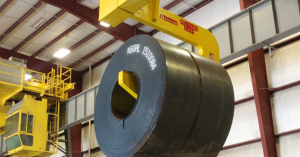 In the realm of lifting and rigging operations, ensuring the safety and integrity of below-the-hook equipment is paramount. These critical components, ranging from hooks and shackles to slings and spreader beams, bear the full brunt of suspended loads. Any malfunction or failure can lead to catastrophic accidents, resulting in property damage, injuries, or even fatalities.
In the realm of lifting and rigging operations, ensuring the safety and integrity of below-the-hook equipment is paramount. These critical components, ranging from hooks and shackles to slings and spreader beams, bear the full brunt of suspended loads. Any malfunction or failure can lead to catastrophic accidents, resulting in property damage, injuries, or even fatalities.
This article aims to provide a comprehensive guide to identifying the top five early warning signs of potential breakdowns in below-the-hook equipment. By recognizing these indicators and taking proactive measures, organizations can prevent costly downtime, avert potential disasters, and maintain a safe working environment.
#1. Visible Damage and Deformation
One of the most obvious signs of impending failure is the presence of visible damage or deformation in the equipment. This can manifest in various forms, including:
- Cracks and Fractures – These can appear in any part of the equipment, particularly in areas of high stress concentration such as welds, corners, and load-bearing surfaces. Regular visual inspections should be conducted to identify any cracks, paying close attention to areas prone to fatigue.
- Bending and Distortion – Hooks, shackles, and other components can become bent or distorted due to overloading, improper use, or collisions. Any deviation from the original shape should be a cause for concern, as it can significantly reduce the load-carrying capacity of the equipment.
- Wear and Tear – Continuous use inevitably leads to wear and tear, especially in areas of frequent contact or friction. Excessive wear on pins, links, and bearing surfaces can compromise the integrity of the equipment and lead to premature failure.
#2. Unusual Noises and Vibrations
While some noise and vibration are normal during lifting operations, any unusual or excessive sounds should be investigated immediately. These can be indicative of underlying problems such as:
- Loose Connections – Rattling or clanging sounds can indicate loose connections between components, such as pins, bolts, or links. This can lead to instability and potential disengagement during lifting.
- Bearing Wear – Grinding or squeaking noises can be a sign of worn or damaged bearings in hooks, sheaves, or other rotating parts. This can cause increased friction, heat buildup, and eventual failure.
- Structural Fatigue – Creaking or groaning sounds, particularly under load, can indicate structural fatigue or stress cracking. This is a serious issue that requires immediate attention to prevent catastrophic failure.
#3. Difficulty in Operation
Any difficulty or unusual resistance encountered during the operation of below-the-hook equipment should be treated as a warning sign. This can include:
- Stiffness or Binding – Difficulty in opening or closing hooks, shackles, or other mechanisms can indicate wear, damage, or obstruction. This can hinder proper engagement and compromise safety.
- Uneven Movement – Jerky or uneven movement during lifting or lowering can be a sign of binding, misalignment, or damage to components. This can lead to load instability and potential accidents.
- Excessive Play or Slack – Excessive play or slack in chains, ropes, or other flexible components can indicate wear, stretching, or damage. This can reduce the load-carrying capacity and increase the risk of failure.
#4. Heat Buildup
Excessive heat buildup in any part of the below-the-hook equipment can be a sign of friction, wear, or malfunction. This can be caused by:
- Bearing Failure – Worn or damaged bearings can generate excessive heat due to increased friction. This can lead to rapid deterioration and potential seizure.
- Overloading – Lifting loads beyond the rated capacity of the equipment can cause excessive stress and heat buildup. This can lead to deformation, fatigue, and eventual failure.
- Brake Malfunction – In motorized equipment, malfunctioning brakes can generate excessive heat due to continuous friction. This can lead to brake failure and loss of control.
#5. Inadequate or Missing Documentation
Proper documentation is essential for ensuring the safe and reliable operation of below-the-hook equipment. This includes:
- Inspection Records – Regular inspections should be documented, including the date, inspector’s name, and any findings or observations. This helps track the condition of the equipment and identify potential problems early on.
- Maintenance Records – All maintenance activities, including repairs, replacements, and adjustments, should be documented. This provides a history of the equipment’s maintenance and ensures that it is being properly cared for.
- Certifications and Test Reports – Below-the-hook equipment should be certified and tested according to industry standards. These documents provide assurance that the equipment meets the required safety and performance criteria.
Regular inspections, proper maintenance, and adherence to safety protocols are crucial for ensuring the longevity and reliability of these critical components. By recognizing these early warning signs and taking proactive measures, organizations can significantly reduce the risk of below-the-hook equipment breakdowns.
Need to schedule an inspection for your below-the-hook equipment? Call (888) 316-2617 and receive a free inspection quote from Crane 1 Services today!
